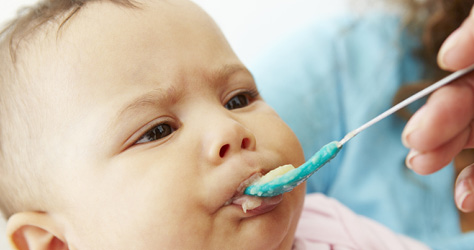Mums know that it’s best to breastfeed babies exclusively for 6 months before weaning onto purées.
How are babies in other countries weaned?
At a glance
- African mums usually breastfeed their babies for between 18 and 24 months, and start to wean around 6 months
- Caribbean mums wean their babies on yams, cassava, pumpkin and sweet potatoes, with arrowroot and cornmeal as cereals
- The first foods that babies in Central and Latin America eat are honey and wheat cereal

Africa
African mums usually breastfeed their babies for between 18 and 24 months, and start to wean around 6 months. Weaning starts with matooke (cooked banana), cow’s milk and maize porridge, moves onto starchy vegetables, like potatoes, sweet potatoes and cassava, progressing to protein-rich sauces that include fish and haricot beans.
The Caribbean
Caribbean mums wean their babies on yams, cassava, pumpkin and sweet potatoes, with arrowroot and cornmeal as cereals. Rice and (black eyed) peas is a West Indian staple, as is calalloo (Caribbean spinach), a nutritious leafy green vegetable.
China and the Far East
Chinese babies are weaned on congee, a watery rice porridge. Congee is a great base to mix with other foods, such as puréed pulses and vegetables. Chinese mums often include ginger and garlic. Some use soy sauce, although we wouldn’t recommend it because it’s salty.
Malaysian mums mix the congee with millet and quinoa as well as puréed vegetables and fruit.
Central and Latin America
The first foods that babies in Central and Latin America eat are honey and wheat cereal. UK guidelines advise against giving honey to babies under a year old because of the risk of infant botulism. These babies are also weaned on avocado, papaya, mango, bananas and rice.
India
Mums in India may exclusively breastfeed their babies until they are 2 years old. Weaning can happen at any time between 6 and 24 months. An Indian baby’s first foods are usually soft rice, with dahls (puréed pulses) bread, sago and vegetables.
For Hindu babies, their first taste of solid food is taken in the lovely Annaprashan ceremony. The baby is dressed in ceremonial clothes, blessed by a priest, and takes a first bite of rice pudding. The baby then chooses from a symbolic object from a tray, that is said to indicate his or her future fortunes.
Inuit
Traditionally, Alaskan Inuit mums breastfed their babies for 3-4 years, although many follow modern American weaning and bottle-feeding practices that shortened this period considerably. Inuit babies can, however, look forward to being weaned on seaweed, nuk-tuk (seal blubber) and caribou meat.
Middle East
Babies in the Middle East tend to be weaned on low protein/high carbohydrate diets. Vegetable soup, rice, bread, pulses and milk puddings make up most of the diet. Eggs and meat are expensive in poorer areas of the Middle East, but there is also a belief that animal protein putrefies in young children’s stomachs, so it tends to be avoided.